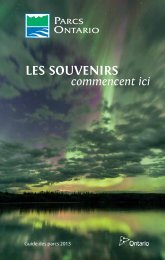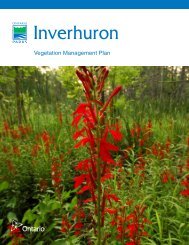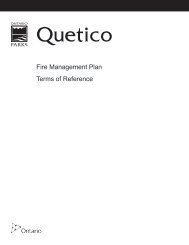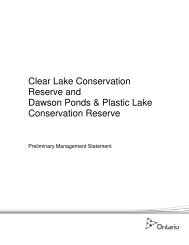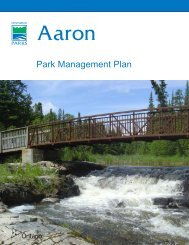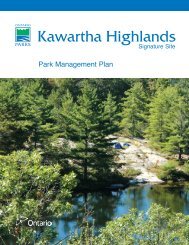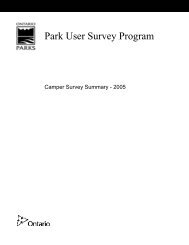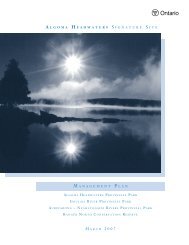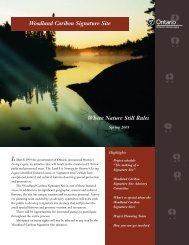Vegetation Plan - Ontario Parks
Vegetation Plan - Ontario Parks
Vegetation Plan - Ontario Parks
You also want an ePaper? Increase the reach of your titles
YUMPU automatically turns print PDFs into web optimized ePapers that Google loves.
4.1.4 Forest Insects and Diseases<br />
Forests will be examined periodically for outbreaks of non-native forest insects and disease that may pose a<br />
threat to forest health or other park values. Control of non-native forest insects and disease will be examined on<br />
a case-by-case basis and will be carried out in consultation with the zone ecologist and OMNR forestry and<br />
entomology staff. Biological controls, such as Bacillus thuringiensis (Bt) will be used whenever feasible to control<br />
insect outbreaks.<br />
4.1.5 <strong>Plan</strong>ting<br />
Species native to the park should be used for restoration or landscape planting (See Johnson and Parker 1975).<br />
If commercial seed mixes are used to re-vegetate disturbed areas (i.e., roadsides, campgrounds, day use areas<br />
and pioneer cemetery), seed mix should be used which contains as many species native to the park as possible.<br />
Where possible plant stock obtained from outside the park for landscape planting and restoration should be from<br />
a local seed source to ensure that they are of a similar genotype and adapted to local growing conditions. <strong>Plan</strong>t<br />
stock derived from park seed may be the preferred option in many cases (see section 4.1.9).<br />
4.1.6 Grass Mowing<br />
Lawns will be mown in the development and historical zones where appropriate to maintain park buildings,<br />
recreational areas, roadways and the pioneer cemetery. In the event that the amount of area to be mowed is<br />
reduced, then careful monitoring should be done to ensure that areas left to natural regeneration are not<br />
colonized by invasive species. Consideration should be given to restoration of these areas using a herbicide to<br />
kill the non-native grasses and then planting with native forest or grassland species (depending on specific<br />
circumstances).<br />
4.1.7 Campgrounds / Trails<br />
The park campgrounds and trails will require general upkeep, including the removal of dead and hazardous<br />
trees and control of Poison Ivy and invasive species, which is permitted under sections 4.1.1, 4.1.2 and 5.0.<br />
4.1.8 Transplanting<br />
Where existing vegetation may be lost due to development, plants may be salvaged and transplanted for<br />
naturalization and restoration purposes within the park. Transplanting vegetation outside the park will be<br />
examined on a case-by-case basis and only be appropriate once park needs have been met. Preference would<br />
be given to local naturalization and restoration projects near the park.<br />
4.1.9 Seed Collecting<br />
Seed Collecting for Use Within the Park<br />
Seed may be collected for use in propagation and planting within the park for restoration and naturalization<br />
purposes. Harvesting effort will be rotated and spread throughout the park. The amount of seed collected will be<br />
limited based on the species and determined in consultation with the zone ecologist (OMNR 2001). Records will<br />
be kept regarding:<br />
10<br />
• The species and amount of seed harvested;<br />
• The location and date of harvesting;<br />
• Where in the park the seed was used.



